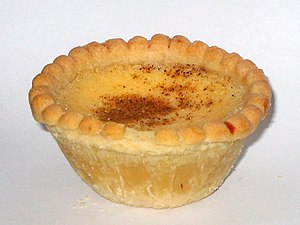Custard tart
 |
|
| Type | Pastry |
|---|---|
| Place of origin | France |
| Serving temperature | cold |
| Main ingredients | Pastry crust, egg custard |
| |
|
Custard tarts or flans pâtissier are a pastry consisting of an outer pastry crust filled with egg custard and baked.
The development of custard is so intimately connected with the custard tart or pie that the word itself comes from the old French croustade, meaning a kind of pie. Some other names for varieties of custard tarts in the Middle Ages were doucettes and darioles. In 1399, the coronation banquet prepared for Henry IV included "doucettys".
Medieval recipes generally included a shortcrust and puff pastry case filled with a mixture of cream, milk, or broth with eggs, sweeteners such as sugar or honey, and sometimes spices. Recipes existed as early as the fourteenth century that would still be recognisable as custard tarts today. Tarts could also be prepared with almond milk during times of fasting such as Lent, though this was rather expensive and would have been popular only with the comparatively wealthy. Often, savoury ingredients such as minced pork or beef marrow were also added (the combining of sweet and savoury ingredients was more common in medieval England), but unlike a modern quiche the custard filling itself was invariably sweet.
Modern custard tarts are usually made from shortcrust pastry, eggs, sugar, milk or cream, and vanilla, sprinkled with nutmeg and baked. Unlike egg tarts, custard tarts are normally served at room temperature. They are available either as individual tarts, generally around 8 cm (3.1 in) across, or as larger tarts intended to be divided into slices.
Custard tarts have long been a favourite pastry in Britain and the Commonwealth. They are often called egg custard tarts or simply egg custards to distinguish the egg-based filling from the commonly served cornflour-based custards. They are sold in supermarkets and bakeries throughout the UK.
...
Wikipedia
